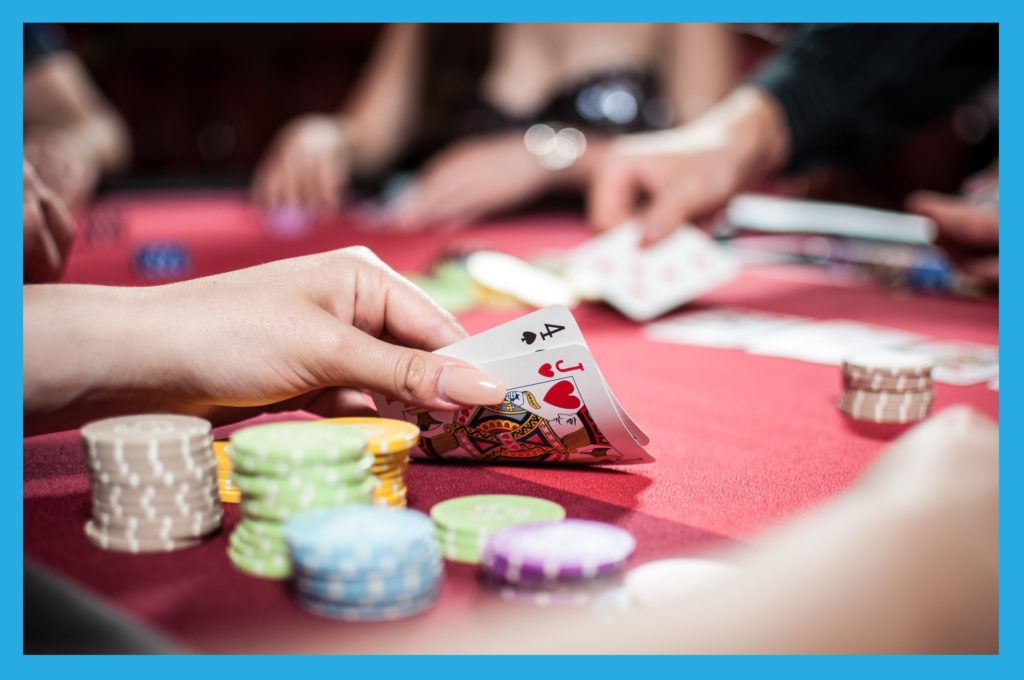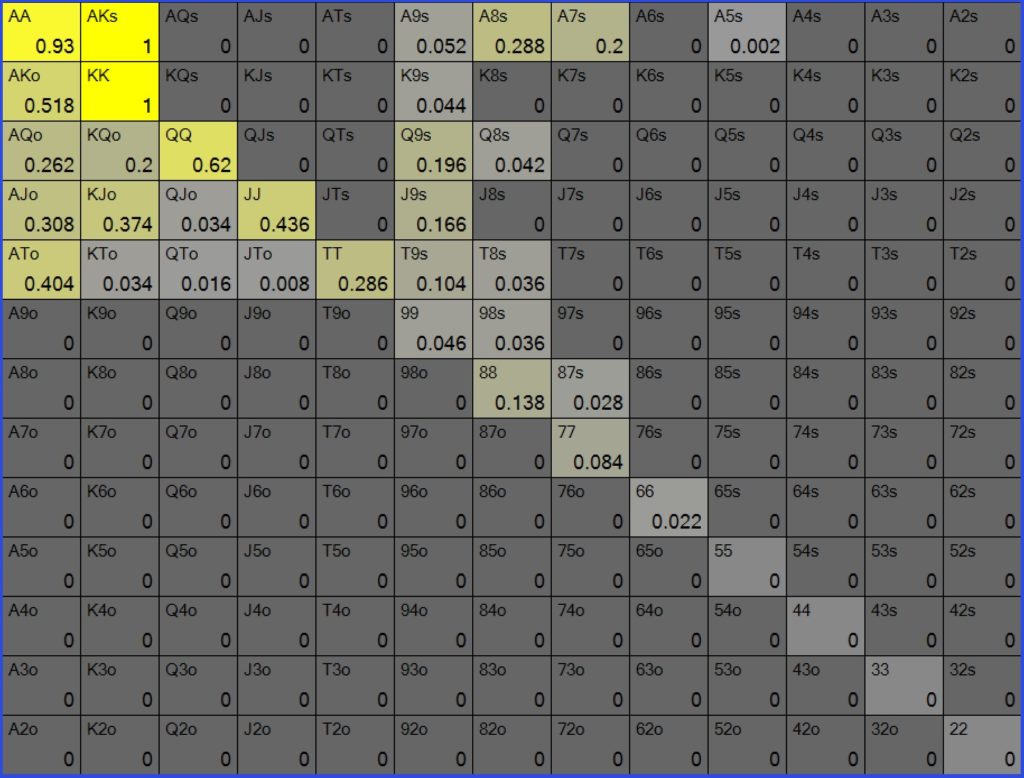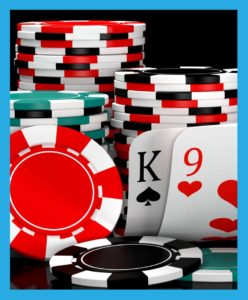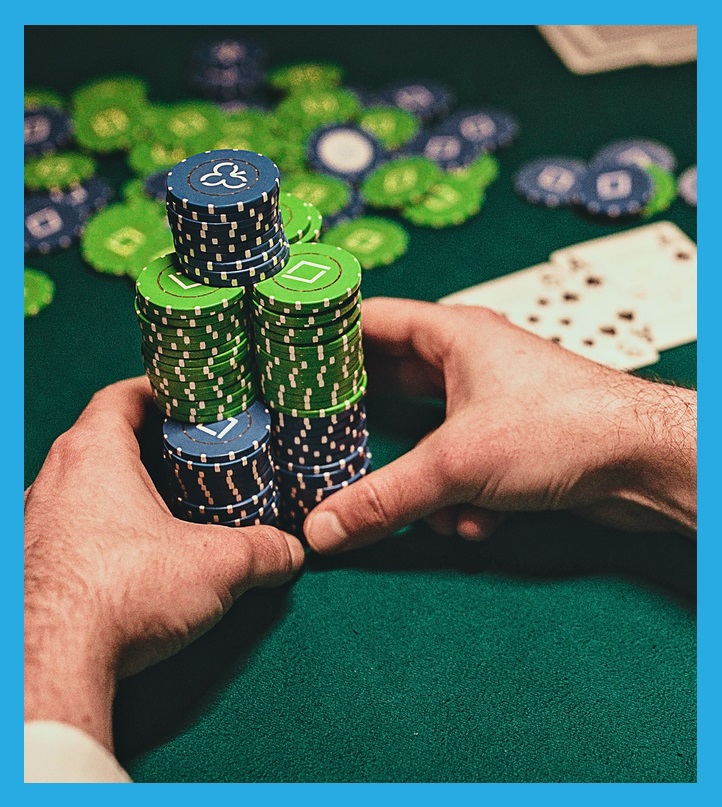While online and live poker are played with the same rules, there are quite a lot of differences you should take into account when transitioning from online to live.
In this article, we'll cover five poker tips you can utilize to make this transition as smooth as possible so you can quickly get to maximize your earnings. Let’s jump right into these key aspects.
1. Prepare for the slow pace of live poker
If you’ve previously played 50-100k hands or 200-300 tournaments per month online, you can expect to play roughly the same number of hands or tournaments in a year in live poker.
This means there will be far fewer exciting hands happening and streaks of being hit by a cold deck can last for days or even weeks (poker variance calculator).

You need to be able to keep your focus sharp and pick up any tells or patterns at the table for extended periods of time. Solid live poker players are both observant and very patient in their play, waiting for the right spots to exploit their opponents.
I've seen good online players get frustrated and enter the pot too loosely just to play some hands. Then this has led to tilt after a bad result.
The points above as well as some other important tips are discussed in the following short video.
[embedyt] https://www.youtube.com/watch?v=ewaP6MH76wQ[/embedyt]A great exercise for keeping focus in live poker is to constantly try and put everyone on a hand range. Try this street to street, even when you’re not involved in a hand. This way you can get better at reading your opponents and will be ready to exploit their tendencies later when you’re in a hand with them.
2. Look for spots to outplay your opponents post-flop
Live games are much softer than online games. Players you face will not have such solid fundamentals and due to having less experience in terms of volume of hands played in their lifetime, they’re often not quite sure how to play their hand on the later streets.
This gives you an opportunity to capitalize on the huge mistakes that live players tend to make. A common trait you'll see is they're overly passive post-flop. They will miss obvious river value bets or get tricky with their monster hands, allowing you to realize more equity and get to showdown cheaper.

Against some player types, you can get away with pushing them out of the pot with pure aggression. Many live players aren't used to playing against an aggressive style.
At the other end of the spectrum, it's a lot more common to have a maniac or whale sit next to you at a live table compared to online games. Depending on the villain, betting thinner for value or potentially calling down lighter could be a couple of simple adjustments you can make to scoop in some nice pots.
All of these points favor playing more hands post-flop. So you can squeeze the maximum value out of the skill difference between you and your opponents.
3. Play a lot tighter against aggression
In most games at casinos or homes, they'll be some looser recreational players driving the action. The stronger live players and regs are typically waiting to feed on these looser players and have developed a lot of patience to do so. What they typically haven't usually developed, however, is solid fundamentals.
This leads us to the first of the three most common mistakes live players make that we can exploit.
Play a lot tighter against 4-bets
Unless you’re facing a 4-bet against a good live pro, you can be fairly certain you’re up against a much value-heavier range than you would be online.
The matrix below displays the GTO 4-bet range for the BTN when 3-bet by the player in the small blind.

We can see from the GTO range commonly used by online pros, hands like A8s are 4-bet almost 30% of the time and Q9s and J9s nearly 20%. Then there's a whole host of weaker semi-bluffs at a frequency (free ranges are available here).
In reality, some live players only 4-bet with KK+, in which case you can consider laying down hands like QQ or AK to a 4-bet. Depending on the bet size and stacks behind, mostly your equity won't justify calling. Even if your opponent 4-bets AKs from time to time, hands like AQ and JJ are not doing great against their tight range and should be folded.
In live games in 2022, still taking exploitable lines is really the knack to consistently winning the maximum.
Kelvin 'AcesUp' Beattie
For online players, folding QQ to a 4-bet might sound absurd at first but live you need to be able to make tough laydowns preflop to be successful.
You should always pay attention to the tendencies of your opponents though, as sometimes a player has just had enough of your aggression and is staging a fightback without the goods – when you get good at live poker, you will have no trouble exploiting the table and game flow dynamics.
Adjust to preflop raise sizes and limping
Whilst you hardly see limping anymore online, live poker games can be a different story. Live players will also frequently vary their preflop raise size. These actions are great, as they often reveal the strength of the player's hand.
Limped pots a plenty in live poker!
Recreational players like to see flops. This means a hand like K9o from early-position or 46s from middle-position could be in a player's limping range. Some players will even limp wider. Be observant and adjust the ranges for players as you learn more about them.
In very 'limpy' games, tightening up could be a viable option. They'll be trickier multi-way pots and some players may be limping in with the intention of re-raising an isolation raise. This is especially common from EP. With more players left to act behind the chance of a raise is higher. So this is where you will see more limp 'traps'. Beware of the UTG limper!

Limping behind with speculative hands is great as there's less chance you'll be blown off your equity by a re-raise and you'll be getting terrific pots odds. Hands like 66 or A4s make great limps.
QUICK LIVE POKER TIP: Be careful with hands like 56s in limped pots. A4s is far superior as you can avoid more cooler situations and will have the nuts more often.
In general, look to isolate a single limper aggressively to get heads-up in-position against a weaker player. Using a linear range is a good approach as a hand like KQ for example will often dominate parts of your opponent's limp-call range (Kxs, KT, etc).
If players are limping in then folding to raises then extending your raising range is going to work well. Just be sure to keep an eye on the number of players left to act as well as their likely perception of the situation. Savvy aggressive opponents behind might suspect what you are doing and take action accordingly.
Here's a video for more about dealing with limpers.
[embedyt] https://www.youtube.com/watch?v=LUmCsDAbTJY[/embedyt]A 10x raise preflop?!
Sometimes seeing a 5x or even 10x raise is also a part of live poker. Again, this conveys useful information about the strength of a player's hand.
Perhaps 10x is a hand like TT that raises larger since it's strong but often has to face dealing with overcards post-flop. So being sure to thin the field, or just take it down preflop could be part of the recreational player's thought process.

Stay cognizant and you'll find you're quickly able to decipher what the raise sizes mean.
Additionally, you can use this to your advantage when you're the one raising. For example, raising super large against some recreational players with some really strong hands. This is a good way to ensure you have a chance to win the maximum in the hand. And the raise size isn't going to look suspicious like it would if you suddenly raised 8x online!
QUICK LIVE POKER TIP: Not only will preflop raise sizing reveal a lot about an opponent's hand but post-flop betting as well. Recreational live players will often bet a size that reflects the strength of their hand.
Fold more often against river aggression
Live players are not comfortable with the idea of bluffing the river in large pots as it puts a large chunk of their stack at risk. As a result, they’re under-bluffing the river, making it easy for you to get away from seemingly good
bluff-catchers.
You’ll do just fine in most live games by reducing your calling frequency against bets or raises on the river, even when the pot odds are good.
There are of course exceptions to this rule – some maniacs can’t stop themselves from bluffing. Against those players, they'll be spots where a call will be profitable with more marginal holdings.
At times, their bluff frequency will be sky-high.

For players that have done some solver work, you may find yourself giving a wry smile when you see the sorts of bluff combinations turned over at showdown by the looser players (if you're interested in finding out more about solvers be sure to check out the following article GTO Poker Solver: Should You Use a Program Like PioSolver in 2022?
4. Use image and tells to your advantage
Phil Hellmuth would tell you that 'white magic' has been a primary factor in his poker success. And whilst it's hard to quantify, there's no doubt image and tells are an important aspect of live poker.
Image
Everything from your table chat to your style of play at the table can affect the way players react to you. Meaning it can potentially be used to manipulate the outcome of a hand.
Since image is about players reacting to you, the profile of the opponent plays an important role. Here are the most common two ways to benefit from your image at the table.
Use of image vs recreational players
This is where image manipulation can at times become more of an art form. Everything from your table chat, the way you bet, to potentially having shown down a memorable hand recently may impact your opponent's decision.
An Australian pro and student of mine, James Broom, has had incredible success from getting under people's skin, yet doing so in the nicest way possible! Using chat and certain mannerisms at the table he's got a great ability to solicit loose calls when he's value betting. There's no doubt this skill has added a significant amount to his bottom line.
William Kousouff has a unique way of pressuring his opponents by using 'speech play'. At times, this can get on the aggressive side and be a bit over the top. It's not something I would recommend but the idea is to find what works for you.
Simply sitting quietly and making sure you aren't giving off tells yourself is completely fine. You can still use image in the way discussed below, which is where it's typically most important.

Use of image vs observant regulars
Here we have a similar element to online poker. In essence, anticipate how our opponents perceive us and try to find ways to benefit from that. If we have a loose image, we can expect to be able to value bet thinner and need to be cautious bluffing.
Oppositely, if an opponent has reason to believe we are very tight, our aggressive play might not get much action and we can look to use some well-timed 3-or-4-bets or some aggressive play post-flop.
Naturally, our image can change over the course of a session/s, in which case, we'll need to re-adjust. So back and forth it goes making it important to stay aware of what your opponent may be thinking about you. This is why it's usually more important against regulars since recreational players are less observant and less capable of adjusting.
The following video discusses image and highlights the important points we've discussed.
[embedyt] https://www.youtube.com/watch?v=EJupU_epCjI[/embedyt]Tells
When I started playing poker 25 years ago there was a huge amount of focus on tells.
I recall noticing a player who would glance at his chip stack if he connected with the board and liked his hand. This tell was literally 100% accurate. No connection with the board and he would stare into space or at his opponents waiting for the action to get to him so he could fold.
The following video spots this tell too on 1978 WSOP ME winner Bobby Baldwyn. Check it out (starts from 9:18).
[embedyt] https://www.youtube.com/watch?v=hidh3ueSpfE[/embedyt]Spotting such obvious tells is fairly uncommon. More typically you'll be piecing together observations over the course of a session/s.
For example, say you've noticed a player spending more time counting out his chips (a common tell) when he's bluffing. Facing a bet on the river and seeing this, you may decide in a close decision where your hand mixes between call and fold to just pure fold.
Looking for tells is not always easy, especially with other important decisions to make in the hand. I wouldn't prioritize it over other core skills. Such as choosing the right size to bet (for more on this critical skill check out the following article, 'How to find the right Bet Size Post-flop in 2022 – The 3 Step Guide'.
These days due to the amount of focus on GTO tells are underused at the live tables. However, it really can make a difference. If you're comfortable enough at the table to do so, be sure to be on the lookout for tells.
5. Get a mentor or training buddy
‘’It’s hard to even imagine where I would be without all the players and friends who I have met through poker over the years. I surely wouldn’t have made it this far! I would say discussing poker and the formats you play with like-minded players is the best way to learn. There are tons of different approaches and strategies to crush poker, and no one said you should be all alone in searching for the best possible strategies.’’
Joni Jouhkimainen, partypoker team pro & high stakes professional
If you can find a player who has crushed live poker for ages, you can really reduce the learning curve.
Learning from your own mistakes is good but also a costly and slow way to make the transition from online to live. Having someone to discuss strategy and hand histories with can be a big help and get you up to speed quickly. Depending on your situation hiring a coach could be a good option.
We hope these tips help smoothen your transition from online to the live felt. This article was brought to you by Pokernerve in collaboration with our friends over at Beasts of Poker.
Finally, If it's live MTTs you're diving into, be sure to check out our Road to Success MTT poker course. It teaches the perfect blend of exploitative and GTO play to get you crushing tournaments in no time.



